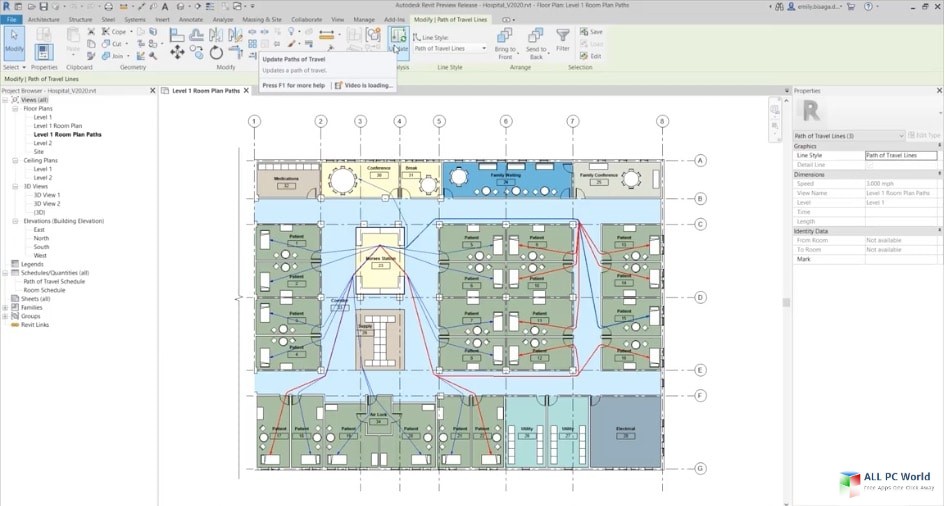

If the update fails (or is not permitted by the API), it’ll delete them and create new ones
When receiving a second time from the same stream, if the received elements have the same applicationId of something that was previously received (and it still exists in the document), the connector will attempt to modify them instead of creating new ones. When a stream is received in Revit the applicationIds of all BuiltElements created are cached in the receiver. If the element was created in Revit it’s the UniqueId, if coming from Grasshopper/Rhino an analogous field  BuiltElements have a property called applicationId, this is different from the id/hash property on them, and represents the id of such element in the host application in which it was first created. Here are some technical details if you're curious about what's happening behind the scenes:
BuiltElements have a property called applicationId, this is different from the id/hash property on them, and represents the id of such element in the host application in which it was first created. Here are some technical details if you're curious about what's happening behind the scenes:  If the element was created in the same project you're working on: for example, if you send some walls to Speckle, edit them, and receive them again from the same stream. If the element was created in another project/software and had been received previously: for example, BuiltElements that were created in Rhino or Grasshopper. This is preferred, as dimensions, ElementIds and other annotations are preserved.Įlements are updated under these two circumstances: The connector takes care of updating received elements automatically where possible (instead of deleting and re-creating them). The Revit connector also works in the Family Editor, refer to the list below for supported element types. If the model is empty, no parameters will be available. The list of available parameters comes from the current elements in the model. For example, in the image below, Speckle will send all elements whose Base Offset value is greater then 2000mm. The parameter filter will filter all model elements that satisfy the logical conditions defined by you. The project info filter lets you add non physical elements, such as levels, views, element types (their properties, not geometry) and project information. The view filter works similarly to the category one, and lets you include all elements visible in one or more views.
If the element was created in the same project you're working on: for example, if you send some walls to Speckle, edit them, and receive them again from the same stream. If the element was created in another project/software and had been received previously: for example, BuiltElements that were created in Rhino or Grasshopper. This is preferred, as dimensions, ElementIds and other annotations are preserved.Įlements are updated under these two circumstances: The connector takes care of updating received elements automatically where possible (instead of deleting and re-creating them). The Revit connector also works in the Family Editor, refer to the list below for supported element types. If the model is empty, no parameters will be available. The list of available parameters comes from the current elements in the model. For example, in the image below, Speckle will send all elements whose Base Offset value is greater then 2000mm. The parameter filter will filter all model elements that satisfy the logical conditions defined by you. The project info filter lets you add non physical elements, such as levels, views, element types (their properties, not geometry) and project information. The view filter works similarly to the category one, and lets you include all elements visible in one or more views. 
The category filter lets you select one or more of the currently-supported Revit categories. Please Note: Elements are sent regardless of whether they are visible or if they were created after setting up the filter. Once a filter is set, just click Send and all objects passing the filter will be sent to your Stream. To help you select which elements will be to sent to Speckle, we've built various filters into our Revit connector. Read up on general guidelines for usage in the Desktop UI section. +Accompanied by companion files that feature drawings, practice and finished plots, figures, etc.This connector uses our shared Desktop UI. +Uses both English and metric units in examples, exercises, projects, and descriptions Most useful for “teach yourself” or instructor-led Revit training. +Designed for novice users of Revit 2019 Architecture. +Covers Autodesk Revit 2019 updates and new features Solving all of the workshops will simulate the creation of three projects (architectural and mechanical) from beginning to end, without overlooking any of the basic commands and functions in Autodesk Revit Architecture 2019. Use the companion files to set up drawing exercises and projects and see all of the book’s figures in color (Files also available for downloading from the publisher by writing to Autodesk Revit Architecture 2019 includes over 50 exercises or “mini-workshops,” that complete small projects from concept through actual plotting. Covering all of the 2D concepts, it uses both metric and imperial units to illustrate the myriad drawing and editing tools for this popular application. This is the most comprehensive book you will find on Autodesk Revit 2019 Architecture.








 0 kommentar(er)
0 kommentar(er)
